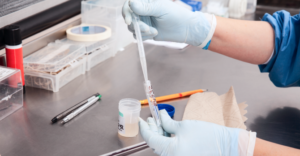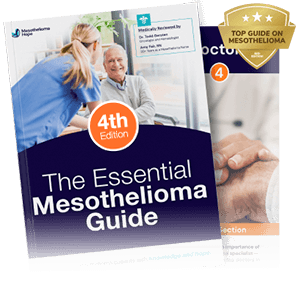What Is Mesothelioma Histology?
Histology is the study of microscopic disease cells and is a subspecialty of pathology, the study of disease.

Clinical histology is a very reliable diagnostic process used to identify many types of cancers, including mesothelioma.
Many mesothelioma specialists favor histology over any other form of diagnosis, including cytology, because it’s the most effective and accurate means of diagnosing cancer.
Determining the histology of mesothelioma involves two steps:
- Doctors perform a biopsy on a patient to collect tissue or fluid samples.
- The samples are sent to a laboratory where an experienced pathologist will review them and look for mesothelioma cells.
If your doctor thinks you have mesothelioma, they may schedule an appointment with you to perform a histology test that can confirm your diagnosis.
Download our Free Questions to Ask Your Doctor Checklist to ensure you get the answers you need during your appointment.
Histology Process for Diagnosing Mesothelioma
Histology samples are collected from a biopsy, a procedure where doctors remove small amounts of fluid or tissue from an area that might be cancerous.
Then, the samples are placed into a container with a preservative and then sent to the pathology lab for examination. From there, pathologists will perform a series of reviews.
1. Gross Examination
The first test performed by a pathologist is a gross examination, which means the tissue sample is reviewed without the use of any tools.
The pathologist will take a look at the specimen with their naked eye and record their observations. In some cases, a photo is taken as well.
Pathologists perform a gross examination to determine whether a sample looks cancerous and to determine which parts of the sample should undergo further examination.
2. Cassette & Microtome Preparation
After a gross examination, the sample is placed into a container called a cassette where it will be processed for a few hours, before being placed in a hot paraffin wax mold. The wax is then left to cool and harden.
Once the wax form is solid, an instrument called a microtome is used to cut the tissue into extremely thin slices. The slices are then placed on a glass slide and dipped into dyes, coloring the cells so they are easier to see.
3. Microscope Review
Finally, the pathologist can look at the biopsied tissue under a microscope. Pathologists consider numerous factors when looking for mesothelioma cells, including cell shape, size, composition, and general behavior.
Mesothelioma samples are typically small, allowing pathologists to review the entire specimen at once.
Mesothelioma specialists often use electron microscopes to review samples. These microscopes use electron beams to create highly detailed images that are magnified to much stronger resolutions than traditional microscopes.
Frozen Section Exam: A Faster Alternative
In some cases, histologists will review a tissue sample during the middle of a surgery. This form of biopsy processing is called a frozen section exam, and it usually takes 10-20 minutes.
Instead of using wax, the tissue is placed into a specially developed solution that encases the tissue and forms an ice cube. Next, the cube is sliced into thin sections, dipped into several staining dyes, and then reviewed under a microscope.
Frozen section exams are used to:
- Determine if a surgeon has removed all of the cancer from a patient’s body
- Identify whether a specific mass is malignant (cancerous) or benign
A frozen section exam is not as accurate as the traditional histology process, but it helps surgeons to make strong caregiving decisions when time isn’t on their side.
Mesothelioma Histology and Cell Types
Pathologists are looking for three types of cells when using histology to identify mesothelioma.
The three mesothelioma histological (cell) types are:
- Epitheliod: The most common mesothelioma cell type.
- Sarcomatoid: The rarest and most aggressive type of mesothelioma cell.
- Biphasic: A combination of epithelioid and sarcomatoid cells.
The presence of any of these cells will result in a mesothelioma diagnosis.
Epithelioid Mesothelioma
Epithelioid cells are found in most mesothelioma cases. This is a good thing as epithelioid mesothelioma is the easiest type to treat and typically coincides with the best prognosis (health outlook).
Epithelioid cells are shaped like squares or rectangles and tend to clump together into large masses.
Sarcomatoid Mesothelioma
Sarcomatoid cells are the least common mesothelioma cell type. They’re recognized by their spindly appearance and multiple nuclei.
Sarcomatoid mesothelioma cells don’t tend to clump together in the same way that epithelioid cells do, allowing them to spread faster. Sarcomatoid cells tend to be linked to the worst patient prognosis.
Biphasic Mesothelioma
Biphasic mesothelioma is the next most common form of the disease after epithelioid. Biphasic mesothelioma tumors are a mix of both epithelioid and sarcomatoid cells. Their appearance is determined by the percentage of each cell type present.
Patient prognosis is greatly influenced by this percentage, with outcomes becoming more favorable with higher concentrations of epithelioid cells.
Learn more about the different histological types of mesothelioma and how they can affect your overall health outlook in our Free Mesothelioma Guide. Order now and get the guide shipped overnight to you.
Procedures to Collect Mesothelioma Histology Samples
The two most common procedures used to collect histology samples in patients who may have mesothelioma are a fine needle biopsy and a thoracoscopy. Learn about each below.
Fine Needle Biopsy
A fine needle biopsy is a common procedure used to diagnose mesothelioma after other tests have indicated that cancer cells may be present.
Although some patients find needles intimidating, the procedure has few risks and is one of the simplest histological means of testing for mesothelioma.
A needle biopsy is a simple procedure and is usually performed in under an hour. Many needle biopsies use a general anesthetic to numb the patient. The doctor will discuss the plan before the procedure to ensure the patient knows what to expect.
Thoracoscopy
A thoracoscopy, also known as a thoracic biopsy or a video-assisted thoracic surgery (VATS) biopsy, is an advanced diagnostic procedure that’s typically only performed after other tests have indicated a patient might have cancer.
Surgeons will make three small incisions into a patient, which are for the camera and tools used throughout the procedure.
Doctors use a tube with a camera at the end to find an area that might be cancerous. Then, they feed tiny tools through the tube to extract a sample.
Since this procedure is performed through three little holes, a thoracoscopy is considered a minimally invasive surgery. Minimally invasive surgeries tend to be lower risk, have fewer complications, and allow faster recovery times than traditional surgeries.
Get your Free Mesothelioma Guide to learn more about the process of diagnosing this cancer.
Biopsies During Surgery
In some cases, histology samples may also be collected during major surgeries, including a pleurectomy with decortication (P/D) or an extrapleural pneumonectomy (EPP).
These biopsy samples are used to further identify a specific cell subtype or contribute to a tissue bank or mesothelioma research project.
Challenges of Mesothelioma Histology
Although histology is one of the most effective ways of identifying and diagnosing mesothelioma, misdiagnosis does occur. Mesothelioma is a challenging type of disease to identify, and even the most experienced pathologists can misidentify the cells.
Mesothelioma is hard to diagnose because:
- Although most mesothelioma cells are malignant, there are recorded cases of patients with benign mesothelioma cells.
- It is rare, and its behavior and appearance often mimic other cancers.
- Mesothelioma cell types each present differently.
Histologists have to feel confident in their observations and work through all of these factors before they can make a mesothelioma diagnosis.
Patients who think their cancer was misdiagnosed should reach out to a mesothelioma specialist. If you’ve been diagnosed with mesothelioma, talk to one of our medical experts now to learn more about getting a second opinion on your diagnosis.
Our team also can help you find top doctors who can collect a mesothelioma histology sample, properly diagnose you, and recommend treatments. Use our free mesothelioma specialist match now to find care.
Mesothelioma Histology and Help for Patients
Malignant mesothelioma histology tests are crucial to diagnosing this cancer properly in many cases. If you or a loved one might have mesothelioma, ask your doctor about getting a biopsy or another histology test.
Your health care team will likely want to rule out more common health issues that could be causing your symptoms using tests like a basic health exam and imaging scans first.
But, if mesothelioma is still a concern after that, you may be able to receive a histology test and confirm your diagnosis.
The Mesothelioma Hope team is here to help you find top doctors who can diagnose and treat your cancer. Get our Free Mesothelioma Guide shipped overnight to you and find out more.
Mesothelioma Histology FAQs
What are the histological features of mesothelioma?
The histological features of mesothelioma depend on which cell type you have.
Histologically, epithelioid mesothelioma cells look like squares and stick together, meaning they don’t spread as fast, according to the UPMC Hillman Cancer Center.
Sarcomatoid cells look like spindles and don’t stick together as well as epithelial cells, so they spread faster through the body.
Biphasic mesothelioma tumors are made up of both epithelial and sarcomatoid cells. If more epithelioid cells are found, the tumor could be easier to treat.
What is the pathology of mesothelioma?
The pathology of mesothelioma is the study of how this cancer progresses. Histology is a subset of pathology involving the study of cells.
Pathologists will examine histological mesothelioma samples under a microscope
What are the characteristics finding of malignant mesothelioma on biopsy?
Pathologists studying a biopsy will want to look for square-shaped epithelioid mesothelioma cells and/or spindle-shaped sarcomatoid cells to confirm that a patient has mesothelioma.
Confirming that cells found in a biopsy are not only cancer, but specifically mesothelioma, is crucial to correctly diagnosing the patient.
What are the main types of mesothelioma histology tests?
Doctors typically can perform two main types of histology tests to diagnose a patient with mesothelioma.
The first is called a fine needle biopsy, in which a tiny needle is inserted to remove a sample of fluid or tissue that could be cancer.
The other is called a video-assisted thoracoscopy, which is a slightly more complex procedure. Here, doctors feed a camera with a tube into a patient’s body after making three minor incisions.
From there, they’ll use tiny tools fed through the tube to grab a tissue or fluid sample.
Both of these procedures are considered biopsies, which are the only tests used to confirm a mesothelioma diagnosis.
How can I get a mesothelioma histology test?
Reach out to your doctor if you’re worried that you or a loved one could have mesothelioma.
Doctors can recommend histology tests if they believe you may have mesothelioma or another type of cancer.





